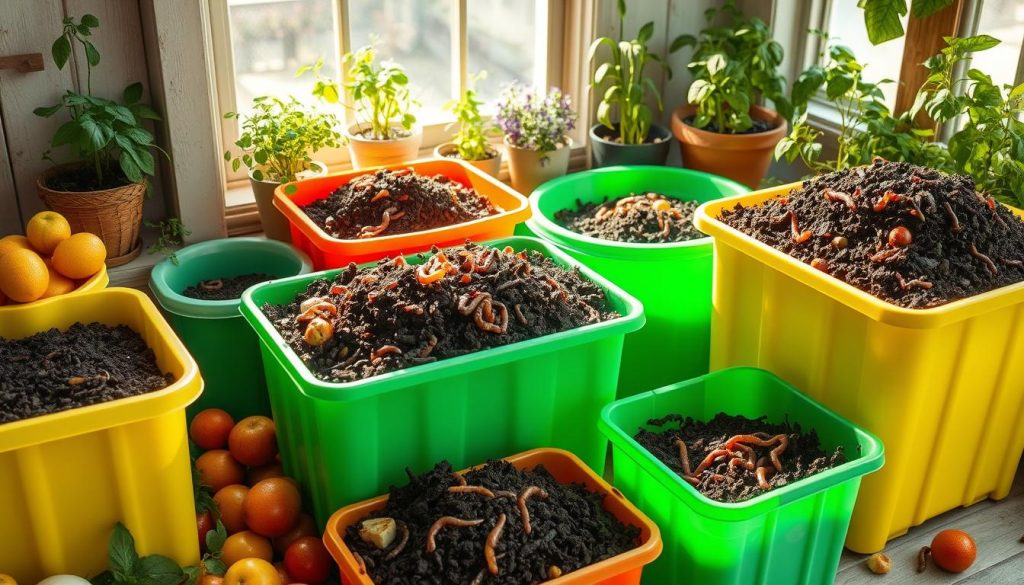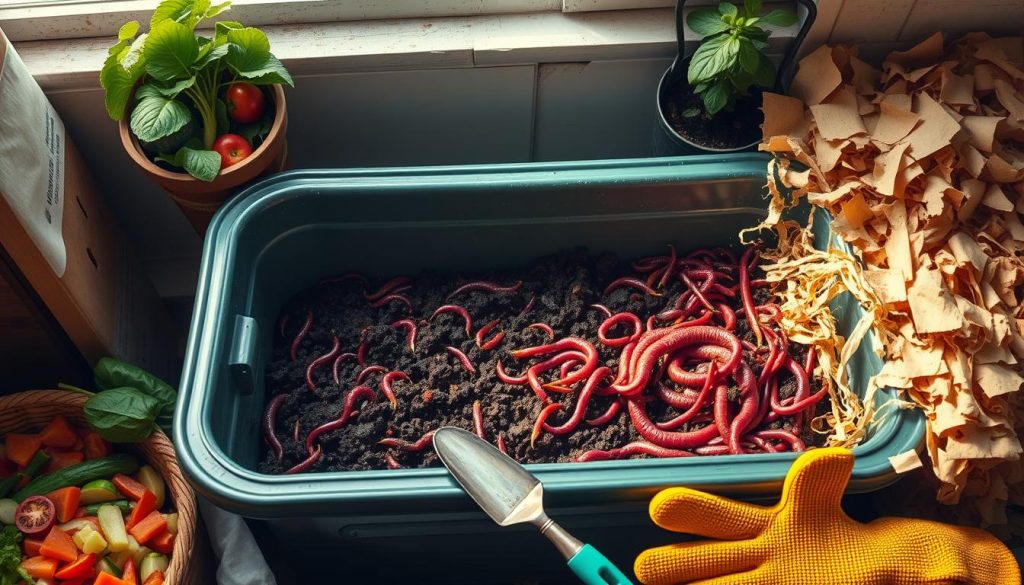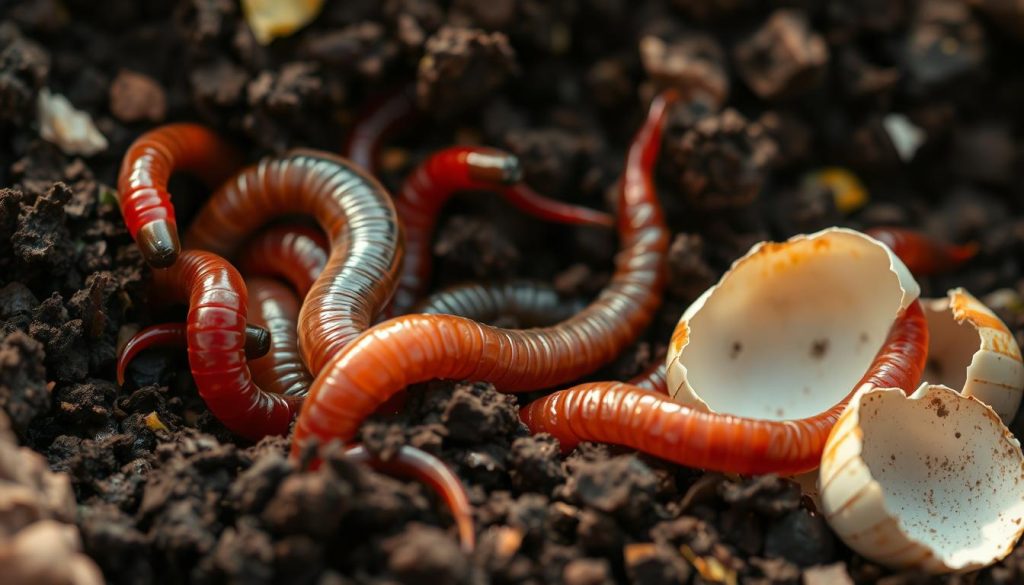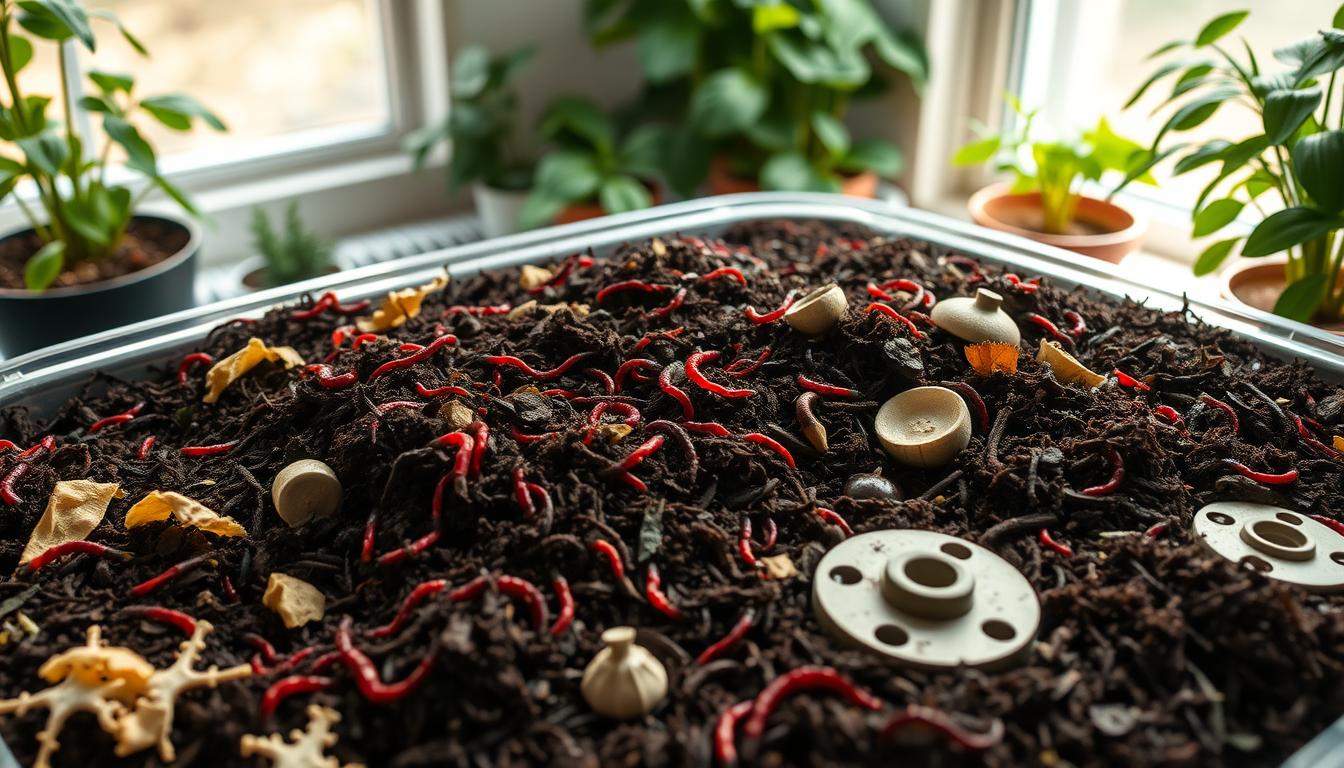I’m thrilled to share my journey with vermiculture. It’s a method that uses composting worms to turn organic waste into compost. This process has taught me a lot about worm bins and how they help the environment. It’s a way to make your garden healthier and greener.
My adventure with vermiculture started with a simple worm bin. It’s now a key tool for me to handle food waste and make compost. Learning about composting worms has shown me how vital they are in this process. By understanding vermiculture and worm bins, we can all move towards a greener future.
What is Vermiculture and Why I Started?
Vermiculture, or vermicomposting, uses earthworms to turn organic waste into compost. It’s a simple and effective way to recycle waste. I started because I love reducing waste and living sustainably. Vermicomposting lets me turn food scraps into something good for my garden.
It helps reduce waste in landfills. Earthworm farming is another name for this process. It creates a space for worms to make compost. This way, my waste becomes something useful, not a problem.
The Basics of Vermiculture
To start vermicomposting, you need to know a few basics. First, pick the right worms, like red wigglers. Then, make a good home for them. The worms eat waste and make compost full of nutrients.
Benefits of Having a Worm Bin
Worm bins offer many advantages. They help reduce waste, make compost, and are homes for worms. Some key benefits include:
- Reduced waste: Vermicomposting keeps waste out of landfills, cutting down on greenhouse gases and methane.
- Nutrient-rich compost: The compost is full of nutrients, great for gardens and plants.
- Low maintenance: Worm bins are easy to care for, needing only occasional feeding and checks.
Setting Up My First Worm Bin

Setting up a worm bin is exciting, especially when you’re eager to use worm castings in your garden. First, pick the right worms and materials for your bins. I chose red wiggler worms, perfect for composting because they adapt well to different environments.
Choosing the Right Worms
When picking worms, think about your climate and waste type. Red wiggler worms are great for composting. They handle various temperatures and moisture levels well.
Selecting Materials for the Bin
The bin’s materials depend on your composting scale. I picked a plastic bin with holes for drainage. Wooden or metal bins work too, as long as they’re well-ventilated and have drainage.
The Perfect Location for My Worm Bin
Choose a spot with steady temperatures and moisture. I put mine in a shaded area, away from extreme weather. This keeps the environment stable for worm castings production.
By following these tips, you can create a great environment for worms. This will help them make nutrient-rich castings for your garden. Keep the temperature and moisture steady, and ensure good ventilation for your worms. This will make your worm composting a success.
| Worm Composting Bin Size | Number of Worms | Amount of Waste |
|---|---|---|
| Small (10 gallons) | 1-2 pounds | 1-2 pounds per week |
| Medium (20 gallons) | 2-4 pounds | 2-4 pounds per week |
| Large (30 gallons) | 4-6 pounds | 4-6 pounds per week |
My Worm Bin Setup Process
Setting up my worm bin was exciting. I learned a lot about vermiculture and composting worms. I picked a bin made for worm composting, with good air and water flow.
I put a 4-6 inch layer of bedding like coconut coir or peat moss at the bottom. This absorbs extra moisture and makes a comfy home for the worms.
Step-by-Step Setup Guide
- Add composting worms to the bin, making sure not to overpopulate it.
- Provide a balanced diet for the worms, including fruit and vegetable scraps, tea bags, and coffee grounds.
- Maintain a consistent moisture level, keeping the bin damp but not waterlogged.
Tips for First-Time Vermiculturists
Remember to be patient and watch your worms. Check the bin often to see if the worms are healthy and happy. Make changes if needed.
Maintaining My Worm Bin

To keep my worm bin healthy, I regularly check and care for it. I feed my worms a balanced diet and manage moisture and temperature. This helps my worms turn organic waste into nutrient-rich compost.
Feeding my worms is key. I add different food scraps like fruit peels, vegetable tops, tea bags, and coffee grounds. It’s important not to overfeed to avoid pests and bad smells. I feed them small amounts often, so they always have nutrients to break down.
Feeding My Worms: What and When
- Adding fruit and vegetable peels, such as apple cores and carrot tops
- Including tea bags and coffee grounds for extra nutrients
- Avoiding meat, dairy, and oily foods that can attract pests
Keeping the bin moist and at the right temperature is also crucial. I make sure it’s damp, like a wet sponge, and the temperature is between 55-77°F (13-25°C). This perfect environment helps my worms work well and recycle waste efficiently.
Harvesting Worm Castings
As I delve deeper into vermicomposting, I’ve hit the exciting part – harvesting worm castings. This step lets me enjoy the fruits of my labor. I use the nutrient-rich castings to fertilize my garden. Through earthworm farming, I’ve learned harvesting is key to a healthy worm bin.
To know when to harvest, I regularly check the worm bin. The castings should be dark, crumbly, and smell earthy. The best time is when the worms have broken down most organic matter. The bin should then be filled with a rich, dark soil-like material.
Techniques for Efficient Harvesting
There are several ways to harvest worm castings, including:
- Hand sorting: carefully sorting through the castings to remove any worms or debris
- Screening: using a screen or sieve to separate the castings from the worms and debris
- Migration: encouraging the worms to migrate to a new bin, leaving the castings behind
Benefits of Using Worm Castings in the Garden
Using worm castings in the garden has many benefits. They act as a natural fertilizer, giving plants essential nutrients. They also improve soil structure, increase water-holding capacity, and support beneficial microorganisms. By adding worm castings to my garden, I’ve seen a big boost in plant health and productivity. Earthworm farming has become a valuable part of my gardening routine.
The Environmental Impact of Vermiculture

Vermiculture greatly benefits the environment. It helps reduce food waste by using composting worms. These worms break down organic matter, turning it into nutrient-rich compost for plants.
Reducing Food Waste
Composting worms are very good at breaking down food waste. They can eat up to half their body weight in organic matter daily. This means a worm composting bin can handle a lot of waste, reducing landfill use and greenhouse gas emissions.
Benefits for Soil Health
The compost from composting worms is full of nutrients and microorganisms. It’s perfect for fertilizing plants. Using this compost can improve soil health, boost crop yields, and cut down on synthetic fertilizers.
Using composting worms and worm composting bins offers many benefits. These include:
- Reduced food waste
- Improved soil health
- Increased crop yields
- Reduced need for synthetic fertilizers
Supporting Local Ecosystems
Composting worms and worm composting bins also help local ecosystems. They reduce the need for industrial farming and support sustainable agriculture. This helps preserve biodiversity, protect water quality, and fight climate change.
| Benefits | Composting Worms | Worm Composting Bins |
|---|---|---|
| Reduced food waste | Yes | Yes |
| Improved soil health | Yes | Yes |
| Increased crop yields | Yes | Yes |
Sharing My Journey with Others
Exploring vermiculture has been rewarding. I love teaching friends and family about worm bins and vermiculture. It inspires them to start their own projects and help reduce waste.
Hosting workshops and events is a great way to share my knowledge. I show how to set up and maintain worm bins. This hands-on experience builds a community of like-minded people.
Building a Community of Worm Enthusiasts
Building a community around vermiculture is key. It helps us promote sustainable practices and reduce our environmental impact. The benefits include:
- Sharing knowledge and expertise to improve our vermiculture practices
- Learning from each other’s experiences and successes
- Collaborating on projects and initiatives to promote sustainable living
My journey in vermiculture has shown me the power of community. By working together and sharing our experiences, we can create a better future. Let’s inspire others to join us on this journey.
Reflecting on My Vermiculture Experience
Reflecting on my journey into organic waste recycling and vermicomposting, I feel grateful. This adventure taught me patience, persistence, and detail. These lessons helped me create a thriving worm bin and grow plenty of worm castings for my garden.
My future goals include growing my worm bin and teaching others about sustainable living. I plan to host workshops and events. My goal is to inspire a new generation of worm enthusiasts to enjoy vermicomposting.
My experiences show how small actions can greatly impact the environment. I urge anyone wanting to reduce their carbon footprint and improve soil health to start a worm bin. This hobby is rewarding for both the individual and the planet.

